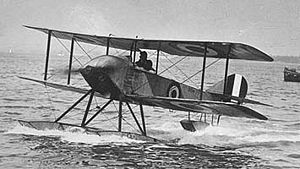Sopwith Tabloid Video - Engine start
|
|
Sopwith Tabloid
Tabloid/Schneider

Picture - The Sopwith Schneider. The aircraft in the photograph is similar to the Schneider Trophy aircraft which, piloted by Howard Pixton, won the 1914 Schneider Trophy in Monaco.
Role: Sports/Scout Aircraft
Manufacturer: Sopwith Aviation Company
First flight: November 1913
Introduction: 1914
Retired: 1915
Primary users: Royal Flying Corps
Royal Naval Air Service
Number built: 40 Tabloid, 160 Schneider
The Sopwith Tabloid and Schneider were British biplane sports aircraft, one of the first to be built by the Sopwith Aviation Company. The "Tabloid" was so named because it was so small, its performance caused a sensation when it first appeared, surpassing the existing monoplanes of the day.
Design and development
The original Tabloid, which first flew in November 1913, was a two-seater with a side-by-side configuration - unusual for the time. It had no ailerons, using wing warping for lateral rolling. It was originally powered by an 80 hp (60 kW) Gnx´me Monosoupape rotary engine and when tested by Harry Hawker at Farnborough the Tabloid reached 92 mph (148 km/h) while carrying a passenger. It took only one minute to reach 1200 ft (366 m). A total of 40 were built.
On 20 April 1914, a floatplane version of the Tabloid, known as the Sopwith Schneider, powered by a 100-hp (75 kW) Gnx´me Monosoupape engine, was piloted by Howard Pixton to win the Schneider Trophy in Monaco. The Schneider Racer was sent to the production line, a total of 160 aircraft were built, with little change from the first.
Attempts were made to operate Schneiders from seaplane carriers, including the HMS Ben-my-Chree, but these were unsuccessful. On 6 August 1915 a Schneider took off from the aircraft carrier HMS Campania.
Operational history
Single-seat variants of the Tabloid went into production in 1914 and 36 eventually entered service with the Royal Flying Corps and Royal Naval Air Service (RNAS). Deployed to France at the outbreak of the First World War, Tabloids were used as fast scouts. Some naval aircraft were armed with a Lewis gun on the top wing, firing over the propeller arc. One other aircraft used a Lewis gun firing through the propeller arc with deflector wedges mounted on the propeller blades.
The Tabloid also operated as a bomber. On 22 September 1914, Tabloids mounted the first raid by British aircraft on German soil. In their most famous mission, two RNAS Tabloids flying from Antwerp on 8 October 1914, raided the German Zeppelin sheds at Cologne and Dx¼sseldorf. The Cologne target was not located, the railway station being bombed instead, but the shed at Dx¼sseldorf was struck by two 20 lb bombs dropped from 600 ft and the Zeppelin Z.IX was destroyed.
The Tabloid was withdrawn from service in early 1915.
Variants
Tabloid Original wheeled version 1914 Schneider Racer Tabloid equipped with floats Schneider Float equipped, production version of Schneider Racer Lebed VII Unlicenced copy of the design built by Lebed in Russia as a military reconnaissance aircraft Lebed VIII As Lebed VII but with revised undercarriage
Operators
United Kingdom
Royal Flying Corps
No. 3 Squadron RFC
Royal Naval Air Service
Royal Air Force
No. 201 Squadron RAF
Specifications
General characteristics
Crew: one
Length: 7.02 m (23 ft)
Wingspan: 7.77 m (25 ft 6 in)
Height: 3.05 m (10 ft)
Wing area: 22.39 m² (241 ft²)
Empty weight: 545 kg (1,200 lb)
Max takeoff weight: 717 kg (1,580 lb)
Powerplant: 1x— Gnx´me Monosoupape 9-cylinder rotary engine, 75 kW (100 hp)
Performance
Maximum speed: 148 km/h (92 mph, 80 knots)
Range: 510 km (315 miles, 275 nm)
Service ceiling: 4,600 m (15,000 ft)
Armament
Some RNAS aircraft fitted with 1 x— forward-firing .303 in (7.7 mm) Lewis gun
2 x— 20 lb (9 kg) bombs
Related development
Sopwith Schneider
Sopwith Baby
Bruce, J.M. "The Sopwith Tabloid, Schneider and Baby: Historic Military Aircraft No.17, Part I". Flight. 8 November 1957. pp. 733-736.
Bruce, J.M. "The Sopwith Tabloid, Schneider and Baby: Historic Military Aircraft No.17, Part II". Flight. 15 November 1957. pp. 765-766.
Bruce, J.M. "The Sopwith Tabloid, Schneider and Baby: Historic Military Aircraft No.17, Part IV". Flight. 29 November 1957. pp. 845-848.
Donald, David, ed (1997). The Encyclopedia of World Aircraft. Prospero Books. ISBN 1-85605-375-X.
Holmes, Tony (2005). Jane's Vintage Aircraft Recognition Guide. London: Harper Collins. ISBN 0 0071 9292 4.
Lamberton, W.M. (1960). Fighter Aircraft of the 1914-1918 War. Herts: Harleyford Publications Ltd.. pp. 58-59.
Thetford, Owen. British Naval Aircraft since 1912. London:Putnam, Fourth edition, 1978. ISBN 0 370 30021 1.
Sopwith Tabloid Pictures and Sopwith Tabloid for Sale.
Living Warbirds: The best warbirds DVD series.
Source: WikiPedia